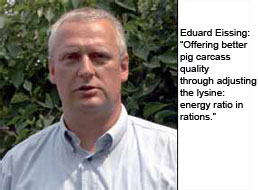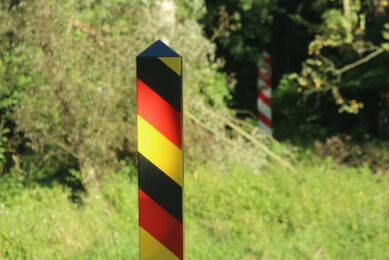Adjusting lysine for lean meat

Careful adjustment of the lysine amino acid through the feeding period doesn’t help weight gain or feed conversion – but with some breeding lines it brings a definite advantage in carcass quality at the end of the day.
The Dutch market leader in hybrid pig sales, Topigs, has introduced a new strategy for feeders of its breeding lines for less fat and higher proportions of lean meat in the resultant carcass. Eduard Eissing, managing director of the company’s German-based organisation Topigs-SNW, reports that trials with a ‘PixTopigs’ slaughter generation (Topigs sows x Piétrain) showed that increasing the protein content of the ration with higher levels of lysine in the first feeding phases while cutting back on both lysine and fat in the ration in the final phase can return better carcass quality. The improvement is sufficient to pay for the extra feed cost involved and still leave an improved margin for the feeder, he says. In one trial at the Iden State Agricultural Research Institute in Saxony-Anhalt, Germany this approach resulted in carcass lean meat increasing from 56.6% to 57.6% (FOM grading). For this result, feed costs ended up higher by almost €1/pig compared with control animals, but more lean meat on the trial pigs brought a bonus much higher than this. At the Iden trial with 80 of this type of pigs on a three-phase regime 25-50 kg, 50-80 kg and 80-110 kg, crude protein in rations was around 19% and 17% in the first two phases with 16.3% (control) and 16.6% (adjusted lysine trial) in the final phase. Lysine for the trial pigs was increased by 0.07% in the first phase, 0.03% in the second and reduced by 0.02% in the last. At the same time ration energy (MJME) was 13.8 (control) and 13.6 (trial) for the first phase and thereafter 13.4 and 13.7 and 13.0 and 13.4 in the last phase. The resultant lysine:energy ratio was significantly altered in this way with the diet containing 0.65 g of lysine per MJ ME from 70 kg liveweight on to slaughter. There was little difference in daily liveweight gain (905 g control against 890 g for the trial pigs), feed consumption (2.43 kg/pig/day against 2.36 kg/pig/day) or feed conversion (2.71:1 against 2.67:1). Killing out percentages were also much the same. But there was more meat (63.3 mm depth against 62.8 mm) and less fat (15.2 mm against 16.1 mm) on the trial group carcasses. Also, the meat quality (pH, conductivity and colour) scored highest for the trial group. Dr Manfred Webber from Iden Research Station said that these results were for that particular breeding line and depended on the management and buildings. Taken in context with the good daily gain (lw) of around 900 g the performance was high in terms of meat quality with a lean meat percentage of between 57% and 58% and backfat thickness down at 2.2 cm.











